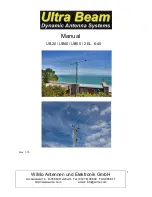
1.800.947.7871 Toll Free in the US
+1.805.262.1600 Sales
+1.805.262.1601 Fax
2101 Corporate Center Drive
Thousand Oaks, CA 91320, USA
To learn more visit:
xirrus.com or
email [email protected]
© 2015 Xirrus, Inc. All Rights Reserved. The Xirrus logo is a registered trademark of Xirrus, Inc.
All other trademarks are the property of their respective owners. Content subject to change without notice.
REFERENCE GUIDE / DATASHEET //
V1.04.MAR.15
Design Considerations and
Reference Use Cases
There are several factors that impact the performance of a
Wireless LAN and must be kept in mind while designing for a
deployment. Some of the key considerations are as follows:
Mobility of the Application:
The mobility of the clients that will be
connecting to the Array through the antenna system is the first
thing to think about when planning a deployment. An application
that has a lot of mobile users, such as a convention center is best
served by a large number of omnidirectional microcells while a
point-to-point application, which connects two or more stationary
users may be best served by a directional antenna.
Physical Environment:
Some of the things to watch for in the
environment where the WLAN deployment is planned include:
• Building construction – The density of the materials used in a
building’s construction determines the number of walls the RF
signal can pass through and still maintain adequate coverage.
The following is a good reference but the actual effect of the
walls on RF must be tested through a site survey. A thick metal
wall, such as an elevator reflects signals, resulting in poor
penetration of the signal and low quality of reception on the
other side. Solid walls and floors and precast concrete walls can
limit signal penetration to one or two walls without degrading
coverage, but, this can vary greatly depending on the amount
of steel reinforcing within the concrete. Concrete and concrete
block walls will likely limit signal penetration to three or four
walls. Wood or dry wall will typically allow for adequate signal
penetration through five or six walls. Paper and Vinyl walls have
little effect on signal penetration.
• Ceiling height
• Internal obstructions – Product inventory and racking are factors
to consider in a indoor environment, such as a warehouse.
In outdoor environments, many objects can affect antenna
patterns, including trees, vehicles and buildings.
• Available mounting locations.
In addition, consideration some consideration should also be
given to aesthetic appearance.
Access to network connections (minimize Antenna cable runs):
Cabling between the Array or AP and the antenna introduces
losses in the system, therefore the length of this cable run must be
minimized as much as possible.
Warehouse Use Case:
In most cases, these installations require
a large coverage area. Experience has shown that multiple
omnidirectional antennas (such as ANT-OMNI-1x1-01 or ANT-
OMNI-2x2-02) mounted at 20 or 25 feet typically provide the
best coverage. Of course this is also affected by the height of
the racking, the material in the racks and your ability to locate
the antenna at this height. The antenna should be placed in the
center of the desired coverage cell an in an open area for best
performance. In cases where the ceiling is too high and the Array
or AP will be located against a wall, a directional antenna may
be used.
Small Office or Small Retail Store:
An omnidirectional dipole
antenna (such as ANT-OMNI-1x1-01 or ANT-OMNI-2x2-02) will
provide best coverage for type of scenario.
Enterprise or Large Retail Store:
In most such deployments, there
is a need for a fairly large coverage area and a combination of
omnidirectional and directional antennas must be used. Omni-
directional antennas located just below the ceiling girders or just
below the drop ceiling and directional antennas located at the
corners. Also, for areas that are long and narrow – such as long
store aisles – a directional antenna at one end may provide better
coverage. Keep in mind that the radiation angle of the antenna
will also affect the coverage area.
Apartment Complex Backhaul (Point-to-Point):
For an application
where last mile connectivity is being provided using Wi-Fi
(such as apartment complexes or senior living complexes that
may not have traditional wiring infrastructure), point-to-point
connections are common. When establishing point to point
connections in outdoor environments, the distance, obstructions
and antenna locations must be considered. For short distances
(several hundred feet), a standard dipole antenna may be used.
For very large distances (1/2 mile or more) high-gain directional
antennas must be used. The antennas must be installed as high as
possible, above obstructions such as trees, buildings and similar.
If directional antennas are used, they must be aligned so that their
main radiated power lobes are directed at each other.
Support & Maintenance
Xirrus is committed to the success of our customers and
provides warranties and support options to best fit your needs..
For further information on the Xirrus hardware warranties,
software support and premium support offerings visit:
http://www.xirrus.com/support/
About Xirrus
To organizations who depend on wireless access to transform
their business, Xirrus is the wireless network solution provider
that provides the world’s most powerful, scalable, and trusted
solutions. Through product invention and system design,
commitment to customer success, and the industry’s best
price performance, Xirrus gives you confidence that your
wireless network performs under even the most demanding
circumstances. Xirrus is a privately held company headquartered
in Thousand Oaks, CA.
Содержание "Rubber Duck" Antenna
Страница 1: ...EXTERNAL ANTENNA GUIDE REFERENCE GUIDE ...




























